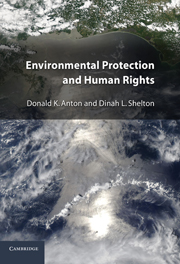Book contents
- Frontmatter
- Contents
- Acknowledgments
- Abbreviations
- Table of Cases
- 1 Law and the Environment
- 2 The Environment as a Human Rights Issue
- 3 An Introduction to Human Rights Origins and Theory
- 4 The International Protection of Human Rights
- 5 International Human Rights Institutions and Procedures
- 6 Procedural Human Rights and the Environment
- 7 Substantive Human Rights and the Environment
- 8 Indigenous Peoples, Rights, and the Environment
- 9 Humanitarian Crises: Armed Conflicts and Other Disasters
- 10 Environmental Rights and International Finance: The World Bank Example
- 11 Human Rights, the Environment, and Corporate Accountability
- Index
6 - Procedural Human Rights and the Environment
Published online by Cambridge University Press: 05 June 2012
- Frontmatter
- Contents
- Acknowledgments
- Abbreviations
- Table of Cases
- 1 Law and the Environment
- 2 The Environment as a Human Rights Issue
- 3 An Introduction to Human Rights Origins and Theory
- 4 The International Protection of Human Rights
- 5 International Human Rights Institutions and Procedures
- 6 Procedural Human Rights and the Environment
- 7 Substantive Human Rights and the Environment
- 8 Indigenous Peoples, Rights, and the Environment
- 9 Humanitarian Crises: Armed Conflicts and Other Disasters
- 10 Environmental Rights and International Finance: The World Bank Example
- 11 Human Rights, the Environment, and Corporate Accountability
- Index
Summary
Introduction
At the 1972 Stockholm Conference on the Human Environment, the United States proposed including the right to a safe and healthy environment in the Stockholm Declaration. The lack of state support for such a right became evident and resulted in the somewhat ambiguous text of Principle 1, which nonetheless links environmental protection and human rights. After Stockholm, environmental scholars and activists began to consider human rights in a more instrumental fashion, identifying those rights whose enjoyment could be considered a prerequisite to effective environmental protection. They focused in particular on the procedural rights of access to environmental information, public participation in decision making, and access to justice and remedies in the event of environmental harm. See, e.g., A.-Ch. Kiss, Peut-on définir le droit de l'homme à l'environnement?, 1976 Revue Juridique de l'environnement 15; Kiss, Le droit à la conservation de l'environnement, 2 Revue Universelle des Droits de l'Homme 445 (1990); Kiss, An Introductory Note on a Human Right to Environment, in Environmental Change and International Law 551 (E. Brown Weiss ed., 1992).
By the 1992 Rio Conference on Environment and Development, the need for public involvement in environmental protection was widely accepted. Chapter 23 of Agenda 21, on strengthening the role of major groups, proclaims that individuals, groups, and organizations should have access to information relevant to the environment and development, held by national authorities, including information on products and activities that have or are likely to have a significant impact on the environment, as well as information on environmental protection matters.
- Type
- Chapter
- Information
- Environmental Protection and Human Rights , pp. 356 - 435Publisher: Cambridge University PressPrint publication year: 2011
- 2
- Cited by



